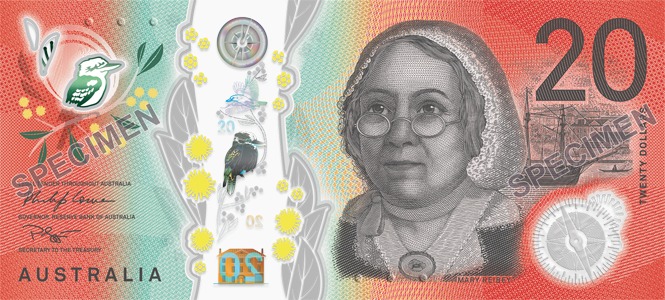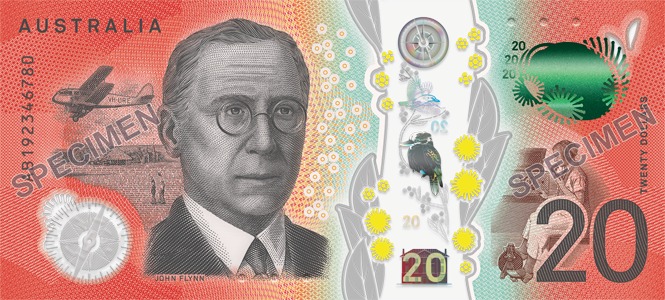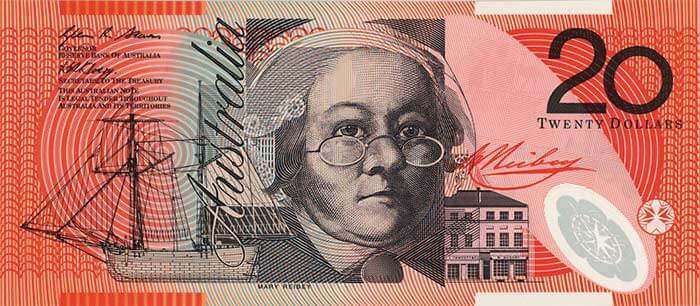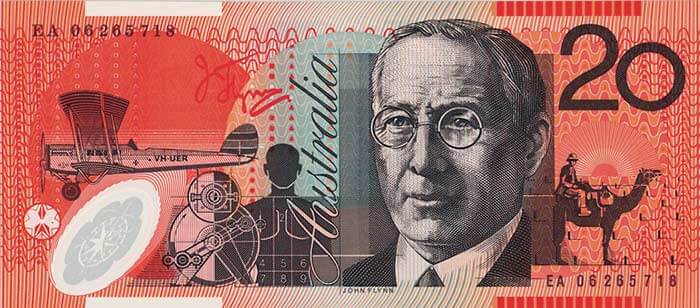$20 Banknote


WHAT'S ON THE NEW $20 BANKNOTE
The new $20 banknote has a range of innovative new security features designed to keep the banknote secure from counterfeiting.
Each denomination of the new series of banknotes will feature a different species of Australian Wattle and native bird within a number of the security features. On the $20 banknote, these are Box-leaf Wattle (Acacia buxifolia) and the Laughing Kookaburra (Dacelo novaeguineae).
The new $20 banknote retains the portraits of Mary Reibey and Reverend John Flynn, which are drawn from the same source photographs represented on the first polymer $20 banknote.
The banknote celebrates Mary Reibey, a convict who arrived in Australia and later became an astute and successful businesswoman running her shipping and trading enterprises, and John Flynn, who pioneered the world's first aerial medical service now known as the Royal Flying Doctor Service. Their work is recognised in several design elements on the banknote, including an image of the RFDS De Havilland aircraft leaving a remote Broken Hill homestead in 1948 and a pedal-powered transceiver used by the service to improve communication in remote areas. The banknote also includes images of a Port Jackson schooner in Sydney Cove in the early 1800s, similar to the type owned by Mary Reibey. Beside it is a traditional Eora nowie (canoe). Aboriginal women fishing from these vessels were a common sight on the harbour in Reibey's time.
DATE OF FIRST ISSUE
The new $20 banknote was released into general circulation on 9 October 2019.
DID YOU KNOW?
- While working as a house servant at the age of 13, Mary Reibey disguised herself as a boy and stole a horse. Her identity was disclosed at the trial when she was sentenced to transportation from England for seven years.
- The microprint on the new $20 includes the names of the ships owned by Mary Reiby: Edwin, Governor Macquarie, James, John Palmer, Mercury and Raven.
- The only known portrait of Mary Reibey is based on a miniature watercolour on ivory c. 1835.


Who's who on the $20 banknote
Mary Reibey built substantial business interests in property and shipping operations. Having assumed responsibility for her husband's enterprises after his death in 1811 and subsequently expanding them, Reibey earned a reputation as an astute and successful businesswoman in the colony of New South Wales. In later life, she became known for her charitable work and interest in the church and education. Images of the schooner Mercury and a building in George Street, Sydney, both of which Reibey owned, are shown on the banknote.
Reverend John Flynn pioneered the world's first aerial medical service, now known as the Royal Flying Doctor Service. Flynn was instrumental in establishing the Presbyterian Church's Australian Inland Mission, a network of nursing hostels. Keenly aware of the isolation of the people of inland Australia, he believed that a ‘mantle of safety’ could only be created through an aerial medical service and the introduction of radio communications. Despite many setbacks, Flynn's vision became a reality when the DeHavilland 50 aircraft Victory (pictured on the banknote) embarked on the maiden flight in 1928.
DATE OF FIRST ISSUE
The $20 polymer banknote was first issued on 31 October 1994.
Did you know?
Mary Reibey was a convict, sentenced to seven years transportation when she was just 13 for stealing a horse. She was disguised as a boy at the time, assuming the identity ‘James Burrow’.
The camel shown on the banknote represents one of five camels purchased by Reverend John Flynn in 1913 for his Patrol Padres, who undertook mission work throughout central Australia.

